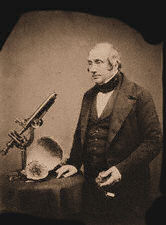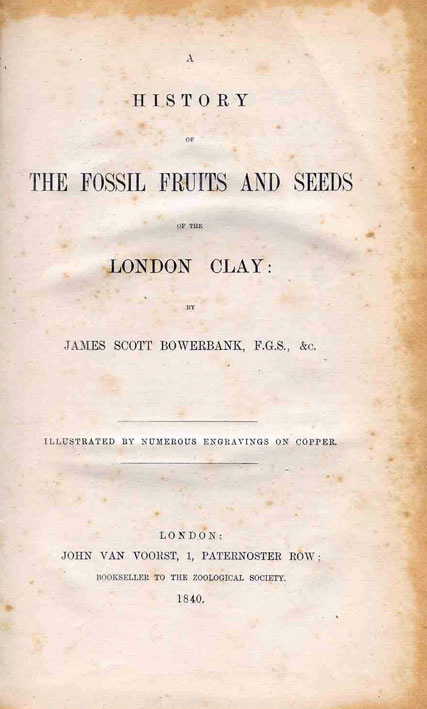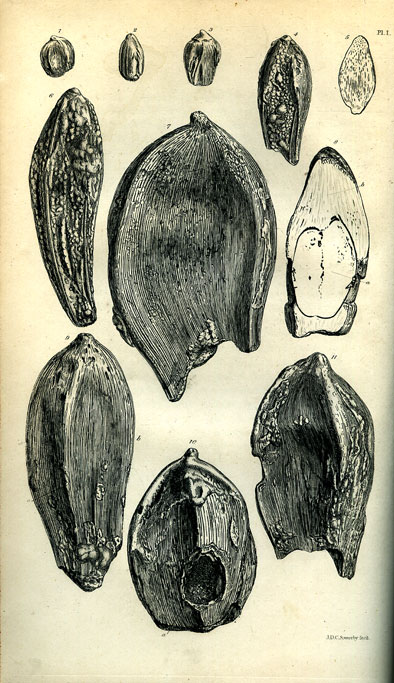
JAMES SCOTT BOWERBANK
Many species have been named after 'Bowerbank', a famous Victorian palaeontologist and as you look through the fossil pages, crabs and fish etc. can be identified bearing his name. The book he wrote about the fossil seeds and fruits is today an exceptionally rare little volume. Published in 1840 very few copies have survived to the present day. The names may have changed but the illustrations are so detailed that they can be easily identified today.



Mr Editor,
I have been so frequently applied to by geologists, as to the best mode of procuring the fossils of the London clay from the Isle of Sheppey, that I am induced to send you a few hints as to the mode of collecting in that locality. Although one of the most accessible, it is probably the least known of any of the rich geological fields that are within a short distance of the metropolis. As a trip to this interesting spot can be accomplished by an absence from London of only three days, and yet the collector be amply laden with fossils on his return, I will endeavour to put your readers in possession of the best mode of conducting such an excursion. The best conveyance is by the Southend and Sheerness steam-packets, which leave London Bridge on Tuesdays, Thursdays and Saturdays, at 11 o'clock in the morning, and reach Sheerness about 4 or 5 o'clock in the afternoon. The town is divided into two parts, - the one contained within the limits of the garrison being designated the Blue-town, while that beyond the fortifications to the north-east is designated the Mile-town; - and it is to this portion that I should recommend the visitor to proceed, and take up his quarters either at the Royal Hotel, or at the Wellington: the latter is an exceedingly snug and comfortable house, and is the one which I have resorted to for many years. After having established yourself in your inn, request the Boots to desire the attendance of Mr. Hays, (better known perhaps by the name of Paddy Hays), from whom you may purchase, at a very reasonable rate, some good fossils, such as crabs, lobsters, heads and portions of fishes and numerous species of fossil fruits. Our traveller will then have accomplished all that can be done towards the acquisition of fossils until the following morning; there not being, I believe, any other collector in the town from whom purchases can be made.
On the following morning I should recommend an early breakfast, as a considerable extent of ground is to be traversed. It is advisable to go provided with five or six sheets of soft paper, to wrap fragile specimens in, and a few cotton or linen bags, of about four or five inches in diameter, to separate the large from the small fossils; the whole to be carried in a good sized blue bag or haversack, no chisel or hammer being necessary on this occasion. If our geologist has a desire to view the great section of the London clay, afforded by the cliffs of the north shore of Sheppey, and is content with comparatively the few fossils which he may be able to procure by his own exertions, he may proceed in the following manner. Leaving Sheerness by the new town, he will pass along the sea wall, toward Minster, until he reaches Scapsgate, where the cliffs begin to rise from the low lands of the western end of Sheppey. A few cottages are scattered round this point, some of the inhabitants of which work upon the beach collecting cement stone or pyrites, the latter being better known by the name of copperas. To these, application should be made to know if they have any "curiosities," and very frequently excellent specimens, and at a small price, will be thus procured. From this point the route will then be beneath the cliffs upon the shingle, amidst which, dark patches, ten or fifteen yards in length, will be observed, composed of nodules of pyrites, intermixed with pyritised fragments of branches of trees, in great abundance. It is at such spots that the numerous and beautiful specimens of fossil fruits are found; but, to ensure success, the collector must be content to go upon his knees, and carefully search among the fragments. The whole of the beach, from about the parallel of about Minster church to Warden Point, abound with these patches of pyrites, and I have by this means obtained in the course of a morning, upwards of one hundred fine fruits of various sizes. Care must be taken in such an investigation of the coast that it be undertaken during the falling of the tide, or unpleasant consequences may arise from being shut in between the shoots of mud which are projected into the sea at many points of the coast. If the principal object be the attainment of the greatest quantity of fossil organic remains, a different course should be pursued. The collector should then, after having made his purchases at Scapsgate, direct his steps towards Minster church, passing which, he will proceed to the road towards Warden. About three quarters of a mile beyond the church, he will find a lane on his left hand, leaving towards the Royal Oak, in which lives a woman named Mummery, and several others, who work upon the beach, and from whom fossils are frequently to be procured. These people will direct our fossil-hunter to many other parties who also work upon the beach, and who reside between this point and Hensbrook, to which our traveller must now direct his steps. At Hensbrook enquiry should be made for a man named Pead, who has usually a considerable number of good specimens in his possession. From this point, Hensbrook, the collector must proceed along the top of the cliff towards Warden, calling at the various cottages in his way, until he arrives at Warden Point, at which place he must enquire for Mud Row, many of the inhabitants of which work upon the beach, and from whom a considerable addition to the specimens already collected may be purchased. Beyond this point, nothing will be obtained, and the best way to return to Sheerness is by the road which runs through the most level portion of the country; the path along the north cliff undulates considerably more than the road. The course of proceeding thus sketched applies to the supposition that the time is limited to three days, but if a greater extent of time can be spared, I should recommend the tourist not to leave Sheerness without viewing the dockyard; and the return to London may be made by the way of Chatham and Gravesend, affording the gratification of a view of the dock-yard and lines at Chatham, and of the fine old cathedral and castle at Rochester; and, at the same time, enabling him to arrive in London on the evening of the same day that he quits Sheerness.
References:


